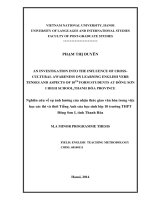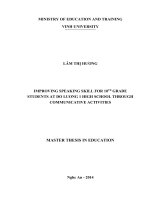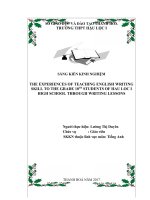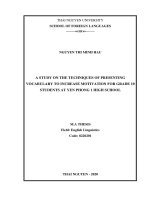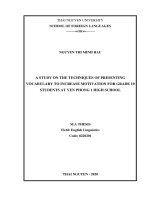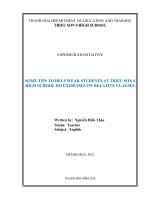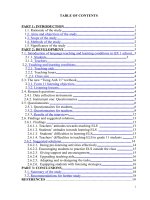A study on improving speaking english through self study activities for 10th students at trieu son 1 high school
Bạn đang xem bản rút gọn của tài liệu. Xem và tải ngay bản đầy đủ của tài liệu tại đây (1.29 MB, 56 trang )
<span class="text_page_counter">Trang 1</span><div class="page_container" data-page="1">
1
<b>DECLARATION </b>
I declare that this thesis is my own work and has not been submitted in any form for another degree or diploma at any university, other institution or tertiary education. Information derived from the published or unpublished work of others has been acknowledged in the text and a list of references is given.
Student
<i><b> (Signature, full name)</b></i>
</div><span class="text_page_counter">Trang 2</span><div class="page_container" data-page="2">2
<b>ACKNOWLEDGEMENT </b>
Many people have contributed to making this thesis what it is. They have given me a lot of help, guidance and encouragement. That motivated me to accomplish the study as perfectly as possible.
First and foremost, I would like to express my deepest gratitude to my supervisor Do Thi Loan, a lecturer at the Faculty of Foreign Languages, Hong Duc University. From the bottom of my heart, I want to thank for her hearted guidance and valuable recommendations. Without her, I might not accomplish my thesis.
Secondly, I would like to send my sincere thank to the headmaster of Trieu Son 1 High School for giving a chance to talk and exchange ideal with teachers and students. I also send my special thanks to all English teachers at school in general and Mrs. Nguyen Thi Huong in particular for contributing her ideals and experiments to help me enrich my thesis and limited knowledge in time of real survey at school and all of members of 10B9 and 10B1. Besides, I highly appreciate the teachers at Faculty of Foreign Languages, Hong Duc University for their precious and profound lessons which provided me solid knowledge backgrounds for my thesis.
Many sincere thanks are also needed to give to the English-major sophomores at Hong Duc University who patiently completed the survey questionnaires and answered my interviewing questions.
Last but not least, I give my warm heart to my family and classmates. They encouraged and supported me to go the end.
</div><span class="text_page_counter">Trang 3</span><div class="page_container" data-page="3">
<b>2. Aims of the study ... 9</b>
<b>The study is aimed at: ... 9</b>
<b>3. Research questions ... 9</b>
<b>4.Method of the study ... 9</b>
<b>5.Scope of the study... 10</b>
<b>6.Design of the study ... 10</b>
<b>PART II: DEVELOPMENT ... 11</b>
<b>CHAPTER 1: LITERATURE REVIEW ... 11</b>
<b>1.1. Speaking Skill. ... 11</b>
<b>1.1.1. What are Speaking and Speaking Skills ... 11</b>
<b>1.1.2. Types of Speaking ... 12</b>
<b>1.2. Types of Speaking Activities ... 13</b>
<b>1.2.1. Types of oral fluency activities ... 13</b>
<b>1.3. Teaching Speaking Skills. ... 14</b>
<b>1.3.1. Relationship between speaking skill and other skills. ... 14</b>
<b>1.3.2. The Importance of Teaching Speaking... 16</b>
<b>1.4. Self-study activities to promote Student‟s Speaking ... 17</b>
<b>1.4.1. Definition of self-study ... 17</b>
<b>1.4.2.Self-study activities to promote Student‟s Speaking ... 17</b>
<b>CHAPTER 2: METHODOLOGY ... 19</b>
<b>2.1. Brief introduction of Trieu Son 1 High School in Trieu Son ... 19</b>
<b>2.1.1. English teaching staffs ... 19</b>
<b>2.1.2. The students ... 19</b>
<b>2.1.3. English learning and teaching condition ... 20</b>
</div><span class="text_page_counter">Trang 4</span><div class="page_container" data-page="4">4
<b>2.1.4. Official text book ... 20</b>
<b>2.2. Data collections and instruments ... 21</b>
<b>2.3. Data collections and analysis ... 23</b>
<b>2.3.1. Questionnaires for students ... 23</b>
<b>2.3.2. Interview for the teachers. ... 29</b>
<b>3.2.1. Way to arange activities ... 35</b>
<b>3.2.2. Techniques to succeed with activities ... 35</b>
<b>3.2.3. Mandatory requirements in the group-speaking product ... 36</b>
<b>3.2.4. Application in learning Speaking skill ... 36</b>
<b>3.2.5. Time to work at home ... 37</b>
<b>3.2.6. Supply Products ... 38</b>
<b>3.2.7.Reviews and feedbacks ... 38</b>
<b>3.3. Model self-study lesson ... 38</b>
<b>3.4. Experimental results ... 40</b>
<b>3.4.1. Experimental results ... 40</b>
<b>3.5. Post-experiment interview results ... 42</b>
<b>3.5.1. Students‟ feeling when join self-study activities ... 42</b>
<b>3.5.2. Preparation & Interview ... 42</b>
<b>3.5.3. Advantages of these self-study activities ... 42</b>
<b>PART III: CONCLUSION AND RECOMMEMDATION ... 43</b>
<b>1. Summary of the study ... 43</b>
</div><span class="text_page_counter">Trang 5</span><div class="page_container" data-page="5">5
<b>APPENDIXE 1: SURVEY QUESTIONAIRE ... 48</b>
<b>APPENDIX 2: INTERVIEW QUESTIONS FOR TEACHER ... 51</b>
<b>APPENDIX 3 : TEST OF THE STUDY ... 52</b>
<b>APPENDIX 4: OBSERVATION SHEET ... 54</b>
<b>APPENDIX 5: INTERVIEW QUESTIONS FOR STUDENTS AFTER EXPERIMENT ... 55</b>
<b>APPENDIX 6: CRITERIA FOR ASSESSMENT OF ENGLISH SPEAKING SKILLS ... 56</b>
</div><span class="text_page_counter">Trang 6</span><div class="page_container" data-page="6">6
<b>LIST OF TABLES, PICTURE </b>
<i>Table 1: Students’ English learning time </i>
<i>Table 2 : Situation students speak English in the classroom Table 3: The result of self-study observation </i>
<i>Table 4 : Scoreboard of experimental group's speaking test results Table 5 : Scoreboard of control group's speaking test results </i>
<i>Table 6: Evaluation table of scoring criteria for English speaking skills Picture 1 : A mind map about protecting the Environment </i>
</div><span class="text_page_counter">Trang 7</span><div class="page_container" data-page="7">7
<b>LIST OF CHARTS </b>
<i>Figure 1 : The most favorite lesson to students’ view Figure 2 : Students’ opinions toward speaking lessons. Figure 3: The importance of speaking skill. </i>
<i>Figure 4 : Speaking activities in the classroom </i>
<i>Figure 5 : Frequency activities using in the classroom </i>
<i>Figure 6 : Table of the rank activities that students prefer to apply Figure 7 : Type of learning Speaking </i>
<i>Figure 8 : Disficulties when joining speaking activities in the classroom Figure 9 : The percentage of the most self-study activities at home Figure 10 : Frequency activities teacher apply in the Speaking lessons </i>
<i>Figure 11 : The difficulties that teacher face while teaching speaking skill to the students </i>
</div><span class="text_page_counter">Trang 8</span><div class="page_container" data-page="8">8
<b>PART I: INTRODUCTION </b>
<b>1. Rationale </b>
A great number of non- English as well as native English speaker use English as an important medium of international communication is every part of the world. English is no longer the language used solely in English speaking countries; rather it is internationally used. As the English language has become an essential factor in strengthening trade and travel in many countries, the necessity of knowing and using this communication through modern technology and media communication devices such as mobile telephone, electronic mail and the Internet. Undoubtedly, people around the world need English as the main medium of their communication via devices. For this reason, speaking is an important skill for the people who are learning English because in verbal communication we cannot communicate with each other without understanding them. Therefore teaching and learning English are very important and necessary because mastering English seems to be one of the best and the shortest ways for us to have a great deal of opportunities to reach the success of life. As for Vietnamese students, especially the high students have many difficulties in learning and practicing English speaking skill. They also fall into confusion when speaking English because of their lack of professional knowledge, confidence and surely good learning methods.
The goal of teaching speaking, surely, is to improve the oral production of the student. Students should be able to make themselves understood, using their current proficiency to the fullest. They should try to avoid confusion in the message due to faulty pronunciation, grammar, or vocabulary, and to observe the social and cultural rules that apply in each communication situation. Speaking well also helps students to access up – to – date information in fields including science, technology and health. Good English speakers will be in a strong position to help their country‟ s economic, social and political development. So by learning to speak English well, students are able to gain a valuable skill which can be useful for their career and contribute to their communication and country.
However, the time to learn English speaking skills in class is limited, so students need to have self-study methods at home under the supervision of teachers.
All these above reasons have inspired the writer to do research on
speaking skill and as a result, a research title goes as: “A study on improving Speaking English through self-study activities for 10<sup>th</sup> students at Trieu Son 1 High school”
</div><span class="text_page_counter">Trang 9</span><div class="page_container" data-page="9">9
<b>2. Aims of the study </b>
The study is aimed at:
- The reality of teaching and learning English in class
- Designing and applying presentation and interview activities in self-studying Speaking skill to grade 10th students at Trieu Son1 High School
- Presenting the effective of using self-study activities (presentation and interview) to learn speaking English
<b>3. Research questions </b>
There are three research questions, based on the focused objectives of the study accordingly. They are:
Question 1.What is the status of teaching and learning speaking skills in grade 10 in high schools?
Question 2.How effective is the use of self-study activities for grade 10 students?
<b>4.Method of the study </b>
In order to attain the primary aims, the researcher has consulted several ideas from the Supervisor and people who fully master this topic. All the theories have been carefully selected and gathered through reference books and documents in the Internet Websites as well.
-Theoretical research method: The author researches the related documents to give some knowledge about vocabulary, definition and features of mind maps and mind mapping technique.
- Investigating methods: The researcher uses survey questionnaires fors students and interview for teaches, tests and observations to investigate the real situation of using self-study activities of grade 10th students in Trieu Son 1 High School.
- Mathematical statistical method: It focuses on presenting, analyzing, caculating the data collected from survey questionnaires and observation to get the final results.
-Experimental method: This method is used to find out about the effectiveness of using self-study activities for learning Speaking skill . Experiment is to verify by using
</div><span class="text_page_counter">Trang 10</span><div class="page_container" data-page="10">10
presentation and interview activities as tools for grade 10th students at Trieu Son 1 School. The research carried out the experiment to comparison then to evaluate the feasibility of using self-study activities as an instrument in speaking teaching and learning.
<b>5.Scope of the study </b>
Research on 20 students in class 10B9 at Trieu Son 1 High school.
<b>6.Design of the study </b>
The study consists of three main parts: Introduction, Development, and Conclusion
Part I: Introduction shows the rationale, the aims, the scope, the method, and design of the study.
Part II: Development includes three chapters:
Chapter 1: Literature review aims to answer the questions related to speaking that introduces the speaking skill and its feature.
Chapter 2: Discussing about researching objectives, method of the study, instrument, data collection and data analysis of the study. This helps examine the real situation of teaching speaking and the need of using various activities in speaking lessons.
Chapter 3: Self-study activities to teach English speaking skills for students in Trieu Son1 High school
Part III: Conclusion.
</div><span class="text_page_counter">Trang 11</span><div class="page_container" data-page="11">11
<b>PART II: DEVELOPMENT </b>
<b>CHAPTER 1: LITERATURE REVIEW </b>
<b>1.1. Speaking Skill. </b>
<b>1.1.1. What are Speaking and Speaking Skills </b>
Speaking is the skill that students will be judged most in real life situation. It is an important part of everyday interaction and most often the first impression of a person is based on his or her ability to speak fluently and comprehensively. However, speaking is in many ways an undervalued skill. This, perhaps, is because we can almost all speak, and so have the low opinion of it. Speaking is often thought of as a popular form of expressions. Speaking, on the contrary, is a skill which deserves attention a bit as much as literacy skill. Our learners often need to speak with confidence in order to carry out many of their basic transactions. There are a number of definitions of speaking which are listed as follows. According to Oxford Advanced Learne‟s Dictionary (2005), speaking is the activity of using voice to say something.
Speaking, as stated by Chaney & Burk (1998), is “the process of building and sharing meaning through the use of verbal and non-verbal symbols, in a variety of contexts.”
Meanwhile, Bygate (1997) defines that “speaking is often thought of as a „popular‟ form of expression which uses the unreligious colloquial register.” However, the research concentrates on analyzing the definition given by Brown (1994) and Burns & Joyce (1997). Speaking is an interactive process of constructing meaning that involves producing and receiving and processing information (Brown. 1994; Burn &Joyce, 1997).
Its form and meaning are dependent on the context in which it occurs, including the participants themselves, their collective experience, the physical environment, and the purposes for speaking. It is often spontaneous, openended, and evolving
</div><span class="text_page_counter">Trang 12</span><div class="page_container" data-page="12">12
However, speech is not always unpredictable. Language functions (or patterns) that tend to recur in certain discourse situation (e.g., declining an invitation or requesting time off from work), can be identified and charted (Burns & Joyce, 1997). For example, when a salesperson asks “May I help you?”, the expected discourse sequence includes a statement of need, response to the need, offer of appreciation, acknowledgement of the appreciation, and a leave-talking exchange.
Speaking requires that learners not only know how to produce specific points of language (linguistic competence) such as grammar, pronunciation, or vocabulary, but also understand when, why, and in what ways to produce language (sociolinguistic competence). Furthermore, speech has its own skills, structures, and conventions different from written language (Burns &Joyce, 1997; Carter& McCarthy, 1995; Cohen, 1996). A good speaker synthesizes this array of skills consisting of listening, speaking, reading, and writing, speaking is the second one which sometimes called “output” or the process of information production. The relationships among the four skills are represented as follows.
Traditionally, when people describe speaking skills, they often focus on speaking and listening skills separately in a context of public speaking. Recently, however, Brown (1981) has expanded definitions of speaking skills by giving three trends of oral communication activities. One trend has been to focus on communication activities that reflect a variety of setting to-many, small group, one-to-one, and mass media. Another approach has been focus on using communication to achieve specific purposes: to inform, to persuade, and solve problems. A third trend has been to focus on basic competences needed for everyday life, such as giving directions, asking for information, or providing basic information in an emergency situation.
It can be said that speaking skills cover a wide range of competences with speaking in public, persuading and influencing others, making a case, chairing a meeting, sharing information.
1.1.2. Types of Speaking
In speaking class, according to Burn, A & Joyce, H (1997), Students must be exposed to three key items:
<i><b>1.1.2.1. Form-focused speaking. </b></i>
</div><span class="text_page_counter">Trang 13</span><div class="page_container" data-page="13">13
Form-focused instruction, that is, attention to detail of pronunciation
When learners begin speaking in another language, their speaking will need to be based on some form- focused learning. An effective way to start is to base speaking on some useful, simple memorized phrases and sentences. These may be greetings, simple personal description, and simple questions and answers. As their proficiency and experience in the language develop, most of these sentences and phrases may be re-analyzed and incorporated into the learner‟ s system of knowledge of the language; language use based on memorization can be the starting point for more creative use of the language.
<i><b>1.1.2.2. Meaning-focused speaking </b></i>
. Meaning-focused instruction, that is, opportunities to produce meaningful
In addition to form-focused speaking, language learners should be exposed to and given chances to practice and use meaning-focused communication, in which they must both produce and listen to meaningful oral communication.
<i><b>1.1.2.3. Opportunities to improve fluency </b></i>
Elements of all these above should be presented throughout a speaking program with emphasis on form-focused instruction at the elementary levels and as the learners‟ progress on meaning-focused instruction at the higher level.
<b>1.2. Types of Speaking Activities </b>
“Speaking as activity in class is much more complex than one might at first think”
-Riddell, 2001:116-
<b>1.2.1. Types of oral fluency activities </b>
<i><b>1.2.1.1. Topic-based activities </b></i>
</div><span class="text_page_counter">Trang 14</span><div class="page_container" data-page="14">14
Topic-based activities ask participants to talk about a controversial subject, the main objective being clearly the discussion process itself. A good topic is one to which students can related using ideals form their own experience and knowledge. Some question or suggested lines of thought can help to stimulate discussion, but not too many arguments for and against should be “fed” to the class in advance, leave room for their own initiative and originality.
List of topic-based activities :
Task-based activities ask students to perform something where the discussion process is a means to an end.
A task is essentially goal-oriented: it requires the groups, or pairs to achieve an objective that is usually expressed by an observable result, such a brief notes or lists, a rearrangement of jumbled items, a drawing, a spoken summary.
Ur (1996:124) pointed out that” the task-based activity scores higher with most groups on all criteria: there is more talk, more it is probably to base most
<b>oral activities on tasks. </b>
List of task-based activities: Complete sentences
Question Matching Information gap
1.3. Teaching Speaking Skills.
1.3.1. Relationship between speaking skill and other skills.
Language has been divided into different skill areas. The first two skills, listening and speaking, are called the oral skills. The last two, reading and writing, are called the literacy skills. They are represented in figure 4.1 (adapted form Forseth ET all. 1994:34)
The four language
</div><span class="text_page_counter">Trang 15</span><div class="page_container" data-page="15">15
As students grow in their language ability and use, the different skills are most often integrated with each other so that they are being used in coordination with each other. In conversation, when one person is speaking another is listening and understanding, the hearer responds by speaking.
<i><b>1.3.1.1. Relationship with listening. </b></i>
Clearly, we have to spend more time in class in developing oral productive skills. However, understanding, or listening, simply can not be left to take care of it. We have to consider what will happen when the students try to use the language for themselves outside classroom, where they no longer have any control over what is said to them. Understanding breaks down almost immediately. Furthermore, poor understanding often makes students nervous and even unable to speak. The first point to be noticed is that it is simply not enough to give the student those samples of spoken language (dialogues or teacher talk). They have been simplified to provide the students with models for oral production. There are two main reasons why these are not enough: a. The students‟ ability to understand needs to be more extensive than their ability to speak (as in the mother tongue), but it is clearly impossible to say how much greater our receptive knowledge needs to be. The diagram below should help to remind us that, in order to be “comfortable” in a foreign language & therefore to be able to communicate effectively- the students need a broad receptive .
PRODUCTION RECEPTION
</div><span class="text_page_counter">Trang 16</span><div class="page_container" data-page="16">16
b. The samples of spoken language in the text book have been carefully designed for oral production, so they do not usually contain enough features of natural speech (e.g. hesitation, false starts…). For developing productive skill, especially at the beginning level, but the students will need much more than this if they are going to be able to cope with real-life language situations. They will need, in short, listening to different models of natural speech. To sum up, the students have to be taught to listen as well as to speak
<i><b>1.3.1.2. Relationship with reading. </b></i>
Like listening, a receptive skill, reading also has some relations with speaking in term of developing each other. Normally, a speaking lesson begins by text which students should find some information for their speaking activities. It may be a paragraph, a magazine, a report, and a book…this show that, reading supports speaking by providing necessary information. Students must have enough information, then, they can use it in speaking production. Therefore, students should be encouraged to read for not only having more information, knowledge but also improving vocabulary.
<i><b>1.3.1.3. Relationship with writing. </b></i>
The relationship between speaking and writing, firstly, will look at factors affecting the choice between speaking or writing and how these factors affect the style and language used. The factors include being face-to-face, saving face, permanence, interactivity in for amativeness, and context dependence in which both speaking and writing can be located , rather than occurring as polar opposites. A spoken and written on the same topic will different in language use relating to grammar, lexis, and style.
<b>1.3.2. The Importance of Teaching Speaking. </b>
Many students equate being able to speak a language as knowing the language and therefore view learning the language as learning how to speak the language , or as Nunan (1991) wrote, “success is measured in terms of the ability to carry out a conversation in
</div><span class="text_page_counter">Trang 17</span><div class="page_container" data-page="17">17
in the (target) language”. Therefore, if students do not learn how to speak or do not get any opportunity to speak in the language classroom they may soon get de-motivated and lose interest in learning. On the other hand, if the right activities are taught in the right way, speaking in class can be a lot of fun, raising general learner motivation and making the English language classroom a fun and dynamic place to be.
<b>1.4. Self-study activities to promote Student’s Speaking </b>
1.4.1. Definition of self-study
Cynthia et al. (2009 : 9) state that self-study is defined according to the role, practice, and/or purpose.
<i>a. Self-study defined by role: Self-study involves a strong personal reference in that it </i>
involves study of the self and study by the self although there are variations of that theme. Hamilton et al. (1998: 236) define self-study as “the study of one‟s self, one‟s actions, one‟s ideas, as well as the „not self‟… Self-study also involves a thoughtful look at texts read, experiences had, people known, and ideas considered”. Developing the Speaking Skills of English ---Ahmed Mohamed Yaoud 193
<i>b. Self-study defined by situated practice: Beck et al. (2004) describe self-study as “a </i>
personal-constructivistcollaborative approach”. Accordingly, self-study has three important overlapping components. Self-study is constructivist because it includes elements of ongoing inquiry, respects personal experience, and emphasizes the role of knowledge construction. Self-study is also collaborative because it acknowledges the important role of the social construction of knowledge.
<i>c. Self-study defined by purpose: LaBoskey (2004a) defines self-study work as moral and </i>
value-laden emphasizing the important moral and political purposes of self-study. Based on the definition of Tang and Yang (2000:15) who define selfstudy as" a way to achieve some form of autonomous learning", the following definition was adopted in this study: Self-study is a way of learning in which a learner is responsible for the learning situation under the supervision of the teacher. During this process the learner can interact with others. According to this definition the role of the teacher is to: 1. give help when s/he is asked for. 2. promote critical thinking. 3. evaluate outcomes.
<b>1.4.2.Self-study activities to promote Student’s Speaking </b>
<i><b>1.4.2.1. Criteria for choosing self of self-study activities </b></i>
a. Activities that aligns with the learning contents in the textbook
- Criterion 1: The content of the speaking lesson in the textbook has some appropriate questions for students to design maps and present topics based on the use of mind-maps.
</div><span class="text_page_counter">Trang 18</span><div class="page_container" data-page="18">18
- Criterion 2: The structure of textbooks creates opportunities for active, proactive, creative learning, forging cooperation skills, and promoting students' potential and independent thinking ability.
b. Encourage students to participate in learning speaking skills at home in the form of small groups
-Criterion 3: Group learning encourages students to learn and share ideas
-Criterion 4: Making mind-maps and practicing speaking through pictures and key-words helps students speak more naturally
Because of criteria, the research decides to choose presentation and interview activities to apply as self-study activities for students to learn Speaking skill. These activities given by Hayriye Kay from web (http:///www.iteslj.org ) can be a suggestion and applicable in a speaking lesson.
<i><b>1.4.2.2. Interviews </b></i>
Students can conduct interviews on selected topics with various people. It is a good idea that the teacher provides a rubric to students so that they know what type of questions they can ask or what path to follow, but students should prepare their own interview questions. Conducting interviews with people gives students a chance to practice their speaking ability not only in class but also outside and helps them becoming socialized. After interviews, each student can present his or her study to the class. Moreover, students can interview each other and "introduce" his or her partner to the class.
<i><b>1.4.2.3. Presentation </b></i>
Due to the relatively limited class time, teachers can assign learners to learn about a topic with questions suggested in the textbook or given by the teacher. home and the next day presented in front of the class. Learners can present individually or in groups, other members of the class listen, comment and ask questions for individuals/groups to present. This activity helps learners to be more active, active and responsible for the learning process.
</div><span class="text_page_counter">Trang 19</span><div class="page_container" data-page="19">19
<b>CHAPTER 2: METHODOLOGY </b>
This chapter aims at showing the attitudes and the expectations of Trieu Son 1 High students in Trieu Son towards teaching English speaking skill. The first section in the chapter reveals the reality and the second deals with the results and analysis of the collected data from survey questionnaires and the interview questions.
<b>2.1. Brief introduction of Trieu Son 1 High School in Trieu Son </b>
Speaking is one of the four important skills in English. It helps student become more self-confident in communication. However, it is difficult to practice it in teaching and learning. It needs the teacher‟ s enthusiasm and the student‟ s effort to decide the success of the lesson.
<b>2.1.1. English teaching staffs </b>
English teachers of Trieu Son 1 High School in Trieu Son are excellent teachers. Most of them are enthusiastic with their job and love their students. They graduated from University and have experience in teaching English. At first period they approached to relatively use specific teaching material- speaking teaching material. Moreover, they actively use and get along with the way of organizing a speaking lesson. In each lesson, they often get use of modern teaching equipment into the teaching course such as: board, the video. They combine them with the lesson content, so many lessons become vivid, attractive and highly effective. However they still face certain difficulties in the implementation of the operation, teaching speaking skill, in the selection of techniques appropriate to each lesson, each stage of the lesson.
<b>2.1.2. The students </b>
The school has 1080 students divided into 27 classes, in which 360 are 10th grade students which are enrolled in 9 classes. Students are intelligent, dynamic and interested in English subject. They are step by step familiar with speaking skill. Many students can understand quite well the English accent in the tape. Most of them can make sentences easily appropriate with teache‟s requirement. Some students had a skill, high technique in learning process. However, many students have a little opportunity to talk, exchange, and access to public information in order to practice speaking English. Some students feel
</div><span class="text_page_counter">Trang 20</span><div class="page_container" data-page="20">20
shy when speaking English because they are afraid of making mistake. English speaking is a new subject to students. Therefore, they get many confuses in keep up with the speed of understand what foreign says in cassette.
The number of students in some class is big. Besides, the class is so noisy that teachers have to spend much time on controlling the students and cannot have enough time to conduct more speaking activities.
<b>2.1.3. English learning and teaching condition </b>
Trieu Son 1 High School of Trieu Son town, Thanh Hoa province. The school was founded in 1965. School has four big blocks with modern techniques. Classes are large and clear in which tablesand chairs are suitable size with most of the student. Besides the studentsalways learn hard and have big effort in learning. During the last 58 years,school received a warming help from the leaders of the provinces, towns, wards and branches of Education, the Board of Representatives parents,companies, factories and construction support to invest new constructionmaterial and continuous improvement of the school on a spacious standard. In the last ten years the school has being maintained traditional “teaching well and learning well", and got achievements also awarded from many certificates of merit, reward flags, medals.
<b>2.1.4. Official text book </b>
English 10 is a text book which continously improves English speaking level of the students by combining it with to listening, reading and writing skill in higher rate. ItIn one lessons which has a vivid and various content. It includes 10 units for 90 periods. Each unit consists of three lesson and each lesson includes all of four skills ( Listening, Speaking, Reading and Writing)
+Lesson 3.1 : Listeing and Reading +Lesson 3.2 : Writing and Speaking
</div><span class="text_page_counter">Trang 21</span><div class="page_container" data-page="21">21
<b>2.2. Data collections and instruments </b>
The survey questionnaires consist of 19 alternative questions designed for students to study the reality of learning speaking skill in Trieu Son 1 High School. Students were asked to tick the most suitable answers which correspond with their opinion.
The survey interview consist of 2 questions designed for the teacher to study the reality of teaching speaking skills in Trieu Son 1 High School.
<i>The survey questionnaires for students( Appendix 1) </i>
Question 1: English learning time of all students
Question2+3+4: studying on students‟attitude toward English lessons in general and speaking lesson in particular
Question 5: Activities teacher often use for students to practice speaking. Question 6: Frequency of Speaking activities
Question 7: Type of learning speaking skills : Work in pairs or in groups or Individual. Question 8: Student‟ difficulties while taking part in speaking lessons.
Question 9: When students speak Enghlish
Question 10 : Self-study activities student used to apply.
The questionnaire was designed for 100 students in 10B1 and 10B9 at Trieu Son 1 High school . In an attempt to assure the objectiveness, faithfulness and effectiveness, the students were not required to write their names as well as other personal information when answering the questions. Besides, the students were provided with clear and detailed guidance and instructions before completing the questionnaire. The given time for them to complete each question was three to five minutes. In the process of the survey, 100 survey papers were handed out and all of them were collected. The number of papers meeting the primary demand of the researcher was 100 (100%).
<i>The interview questions for teachers( Appendix 2) </i>
Question 1: Getting to know teacher‟ attitude about the role of English speaking skills, kinds of working in speaking activities as well as their activities to encourage their students to speak.
Question 2+3+4 : Activities speaking teachers use to teach in the classroom and the reasons why teachers choose them
Question 5: Teachers‟difficulties when teaching speaking.
Question 6 : The reason why teacher rarely use Interview and Presentation activities . The interview was designed for 10 English teachers at Trieu Son 1 High school. I collect opinions and comments of senior English teachers as documments to learn about the current situation of teaching English speaking at school as well as the activities that teachers often apply, thereby proposing some new activities.
</div><span class="text_page_counter">Trang 22</span><div class="page_container" data-page="22">22
<i>Test of the study (Appendix3) </i>
In the study, tests are very important and necessary to survey the students‟ spkeaing skill. Through the tests, the researcher could check about Vocabulary, Grammatical Accuracy , Fluency and Comphrehension and Pronunciation . The speaking tests in basic grade 10<sup>th</sup> at Trieu Son 1 High School are not organized separately so that the teacher had to check students by a separate speaking test from form of level B2 English. The test was divided into two stages: one test for the students when starting the research (pre-test) and another when finishing the experiment (post-test). The pre-test (Appendix 3) is the final test scores of these 20 students at the end of the 1st semester (the score data are taken from the instructors directly teaching). The post- test (Appendix 3) after the end of 2 months of experimentation (February-April 2023) is a test prepared according to the topics mentioned in the English 10 textbook (which has been reviewed and evaluated by English teacher). In the final test, the 10B9 English teacher – Mrs. Huong will check and give marks for students with the assessment of supervisor. The pre-test and post-test have the same level. With pre-test, it involved 4 main topics in grade 10 curriculum programs: Family Life (Unit 1 in English textbook), Entertainment and Leisure (Unit 2 in English textbook), Shopping (Unit 2 in English textbook) and International Orrganizations and Charities (Unit 4 in English textbook). The content of post-test : Gender Equality (Unit 5 in English textbook), Community Life (Unit 6 in English textbook) ,Invention (Unit 7 in English textbook) and Ecology and The Environment (Unit 8 in English textbook).
The time allowance for each test in this study is 15 minutes. The tests consist of 2 part with the total of 10 points: Part 1: Social life questions and Part 2 : Discussion questions.
The result of pre-test and post-test are classified into 3 levels: Average level is from 5 to 6.5 points, good level from 7-8 points, very good level from 8-10. The pre-test is the resuts of first term semester and the post-test is done after sixth week. Then, it will be compared between the results of two tests for students.
<i>Observation (Appendix 4 ) </i>
Classroom observation is a method of evaluating and recording specific information about what is going on within a self-study session. The author watches and follows all the procedures and activities students are performing in the self-study setting, which enables the researcher to elicit reliable data. In other words, it is a means to check the reliability of the data collected for other sources. Researcher use observation sheets (Appendix 4) in order to evaluate the lesson.
</div><span class="text_page_counter">Trang 23</span><div class="page_container" data-page="23">23
<i>The interview questions for students( Appendix 5) </i>
Question 1 : There are interview questions for students after experimental process to learn about their atitudes and their feeling when study English speaking activities Question 2 : The way students prepare for activities
Question 3 : The efective of using presentation and interview activities to study Speaking skill.
<b>2.3. Data collections and analysis </b>
<b>2.3.1. Questionnaires for students </b>
After the survey was implemented, the statistic were totaled up and indicated through out the following charts. Each chart shows us the number of students who choose the most suitable answer for them in each question. This number is counted in percentage unit and the kind of chart are bar, pie, table...The data can be easily seem in the chart and in the right of chart are the explanations.
<b>Question1-Appendix1: Students’ English Learning Time. </b>
The following table illustrates their duration of learning English.
years Percentage of
<i>Table 1: Students’ English learning time </i>
The table above illustrates the time of 100 students in 10B1 and 10B9 at Trieu Son 1 High School. As you can be seem from the table, of all the student, there are only 6 students (6%) have been studying English for 5 years. Whereas, the percentage of students studying English more than 7 years is 9 times higher than those students, students 54 (54%).the rest of these students with 40% have spent 7 years to study. Form the figures, it is clear to see that almost students have been learning English for a long time, from the primary school. It is likely that there would be some differences in their proficiency.
</div><span class="text_page_counter">Trang 24</span><div class="page_container" data-page="24">24
<b>Question 2-Appendix 1: Students’ interest in learning English skills. </b>
<i> Figure 1 : The most favorite lesson to students’ view </i>
The pie chart above illustrates the favorite lessons that students are interested in. It can not be denied that, prominent among the four subjects is speaking, with (56%) more than of the students are fond of speaking .Writing seems to attract a certain number of students are 20 (20%) and (17%) of them said that they like reading. On the contrary, listening is only occupies 7% the smallest percentage according to students‟opinion. In conclusion, it might be possible that, because of studying English for the secondary school, many students concentrated in speaking lesson and it seems to be their favorite subject in class.
<b>Question 3-Appendix 1: Students’ opinions toward speaking lessons. </b>
From the chart shows that the view of 10<sup>th</sup> grade students toward speaking lessons. It can seen the high percentage of the students like speaking lesson 76 students (76%) found speaking lesson interesting. This is understandable because in the pie chart in question 2, more than of the students like speaking skills (15%) is very interesting in it. Therefore, it seems that the students have realized the need of the students and know how to make it interesting for the students through various activities. Anyway, there are still some students don‟t like speaking lesson. Hence, to these students, speaking lesson is not very interesting, 8%, even not interesting. However, the number of students found speaking is not interesting just occupies (2%), a very small percentage rate. It raised a question whether speaking lessons satisfy the entire student‟ need or not. It is because they have not been taught enough grammar, structure as well as their demand to make the lesson more interesting and effective for them.
</div><span class="text_page_counter">Trang 25</span><div class="page_container" data-page="25">25
<i> Figure 2: Students’ opinions toward speaking lessons. </i>
<b>Question 4-Appendix 1: Students’ opinions toward the role of speaking skill. </b>
The studen‟s favorite lesson and their thought of speaking lesson affect them attitude about the speaking skill. According to chart above, most of them realize that speaking skills were very important, which occupies (98%).Meanwhile, 2% of them thought speaking skill is important. None of them think the speaking skill is not very important or even not important. This can reflect that 10<sup>th</sup> grade students are aware for the essence of this skill to them in their study; it is a good sign for the teacher to find the ways to motivate speaking skill more adorable with this skill.
<i> Figure 3: The importance of speaking skill. </i>
</div><span class="text_page_counter">Trang 26</span><div class="page_container" data-page="26">26
<b>Question 5-Appendix1. Have you ever learned English speaking skills by these activities ? How often do you join these activities in speaking lessons? </b>
Look at the graph, we can see the most popular activities teacher uses to teaching Speaking skill is Matching and complete sentences with the same level (80%). Beside, orthers activities such as : Role-play, Game,Question, Informtion gap, Picture and Song aslo have the high percentage of students joining. However, Presentation and Interview activities seems to be used rarely.
<i>Figure 4 : Speaking activities in the classroom </i>
</div><span class="text_page_counter">Trang 27</span><div class="page_container" data-page="27">27
Chart 5 shows the frequency activities using in the classroom. It can be seen that Role-play,Matching and Question are very popular and they are often used . Sometimes, teachers apply more activities to motivate students to speak English like Game and Story telling, for example.
<b>Question 6-Appendix1. Please rank the following activities form 1(the most interesting) to 8 (the least interesting) in this table. </b>
<i>Figure 6 : Table of the rank activities that students prefer to apply </i>
The student‟s favorite activities is Role-play with 88% of all students to choose. Question and Information gap and Story telling are also chosse by 56%-64% at all. Meanwhile, Matching and Song are not well more .It can be considered that most of students prefer to work in pairs or in groups.
<b>Question 7-Appendix1. Do you like English speaking activities in pairs or in groups </b>
</div><span class="text_page_counter">Trang 28</span><div class="page_container" data-page="28">28
According to chart above, the students prefer to study in groups with 76% , the sencond level is Work in pairs with 67% . Finally, the students don‟t like work in individual more with 42% at all choosing dislike .
<b>Question 8-Appendix1. Which difficulties do you have when you join activities to practice speaking English ? </b>
<i>Figure 8 : Disficulties when joining speaking activities in the classroom </i>
Most of students said that they are shy when speak English in front of the class so that we don‟t practice English more in the class. Besides, they afraid to make mistakes about grammar or structures when speaking English. They aslo feel run out of ideas when talking about topic because of lack of vocabulry.
<b>Question 9-Appendix1. When do you speak English in the English speaking class? </b>
When your classmates talk to you 56%
<i> Table 2 : Situation students speak English in the classroom </i>
The table shows that students just speak English when asked with 90% at all . They aslo feel more exciting to speak English when find out a favorite topic . Finally, 56% students said that they speak only when work with their partners .
<b>Question 10-Appendix1. Do you have any self-study activities at home about </b>
</div>